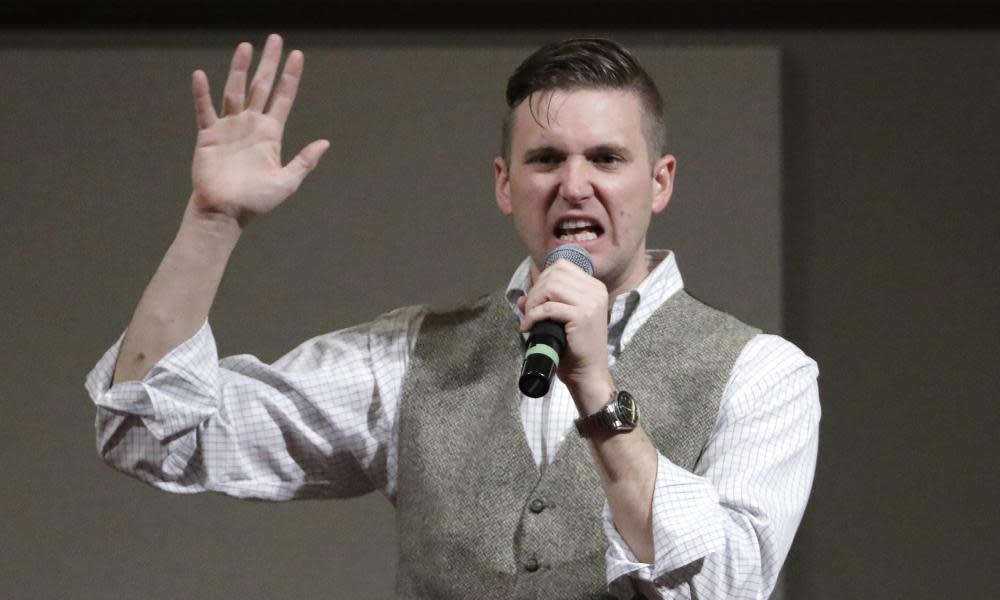The American far right is crashing after its Trump victory high

When I assessed Donald Trump’s first 100 days in office for my book The Far Right in America, I concluded that “the Trump administration is a chaotic beehive of various factions, which are isolated from and opposed to each other, and all vie for the attention of the president”. In essence, little has changed, even if many of the personalities have since moved on. And the reason is simple: this is how Trump likes it!
Within the White House, the far right has been practically decimated. With Steve Bannon’s departure, and recent excommunication, the Breitbart faction has become marginalized. Clowns like “Dr” Sebastian Gorka have been kicked out, while others, including his wife, Katharine Gorka, work under the shadow of being purged, too. The attorney general, Jeff Sessions, has fallen out of Trump’s favor, but remains influential within the Department of Justice and a continuing threat to the rights and protections of minorities.
The only one to (so far) survive the president’s ire, despite being close to both Bannon and Sessions, has been Stephen Miller, who almost effortlessly transformed from Sessions’ communications director into Trump’s senior policy adviser. His CNN interview earlier this month might have jeopardized his strong position, however, bringing not just more scrutiny from liberals like the former Virginia governor Terry McAuliffe, but also from the “audience of one” that Jake Tapper referred to. Because while Trump loves people who go out in the trenches of the (liberal) media to defend him, he does not tolerate “losers”, however he defines that term, as an unprecedented list of political has-beens evidences – anyone still remember “the Mooch”?
What happened in Charlottesville on 12 August?
White nationalists gathered in Charlottesville, Virginia, to protest against a plan to remove a statue of Robert E Lee, the Confederacy’s top general in the American civil war.
Demonstrators chanted racist statements, carried antisemitic placards and held torches during the “Unite the Right” rally, which was organised by white nationalist Jason Kessler.
The march was met by anti-fascist demonstrators, and some skirmishes broke out before James Fields, 20, allegedly ploughed a car into a group of counter-demonstrators.
Civil rights activist Heather Heyer, 32, died and others were injured. Fields has been charged with murder.
Outside the White House, the situation of the far-right movement is not much better. The extreme right, hiding behind the term “alt-right”, of racists like David Duke and Richard Spencer has expressed great political ambitions, but has been unable to bring together more than 100 people since the deadly demonstration in Charlottesville in August. They remain an online troll army, which mainly survives because of the disproportionate attention of the (mostly liberal) media. They have no political relevance outside of their violent potential.
At first sight, the situation of the radical right seems the exact opposite, with authoritarianism and nativism dominating the political debate and presidential tweets. But while radical right discourse dominates US politics, and radical right policies have become mainstream within broad sections of the “conservative” movement, radical right leaders and organizations are struggling to adapt to the changed environment.
Within the Republican party, longstanding radical right politicians like Dana Rohrabacher of California and Steve King of Iowa might have become even more open about their nativism and support for Vladimir Putin, but they remain fairly marginal within both Congress and the White House. At the same time, at the local and state level, many establishment Republicans now run radical right campaigns, hoping to profit from the illustrious Trump effect, but it is doubtful they will actually vote as radical rightists (if they get elected). And even if they do, it is doubtful it will be enough for the still radicalizing base, who in 2016 considered former “Tea Party warriors” as “establishment Republicans”.
Outside of the party, the radical right movement is going through withdrawal after its 2016 Trump high. Stalwarts like Breitbart have not just lost their man in the White House but also their distinct voice within the rightwing media landscape. As Nicole Hemmer has persuasively argued, with the conservative media now fully embracing the president, Breitbart has become “just another right-wing Trump cheerleader”. Rather than setting the agenda for Trump directly, radical right media like Breitbart and the Daily Caller can at best hope to influence Fox News anchors like Tucker Carlson and shows like Fox and Friends, who have the most direct line to the president: his television set.
Even after one year in office, it remains difficult to determine the state of the far right in Trump’s America. There is no doubt that the president himself has strong far-right instincts, as his many authoritarian, nativist, and even racist statements show over and over. But Trump is neither an ideologue nor a politician. His instincts tend to lead to shoddy executive orders, which are shot down later, rather than effective policies that survive judicial scrutiny. Hence, his administration’s policies have been mostly conservative (on steroids) rather than radical-right.
At the same time, his personality and power have transformed both the mainstream and radical right from relatively strong, independent movements into increasingly loose collections of individuals and organizations who chase the president’s favor at whatever price, including ideological consistency and organizational independence. This has led to a situation where the differences between the old right (eg Fox News) and the new right (eg Breitbart) have become negligible, marginalizing the latter rather than the former. And that is just how Trump likes it.
Cas Mudde is the author of Populism: A Very Short Introduction and The Far Right in America

 Yahoo News
Yahoo News 
